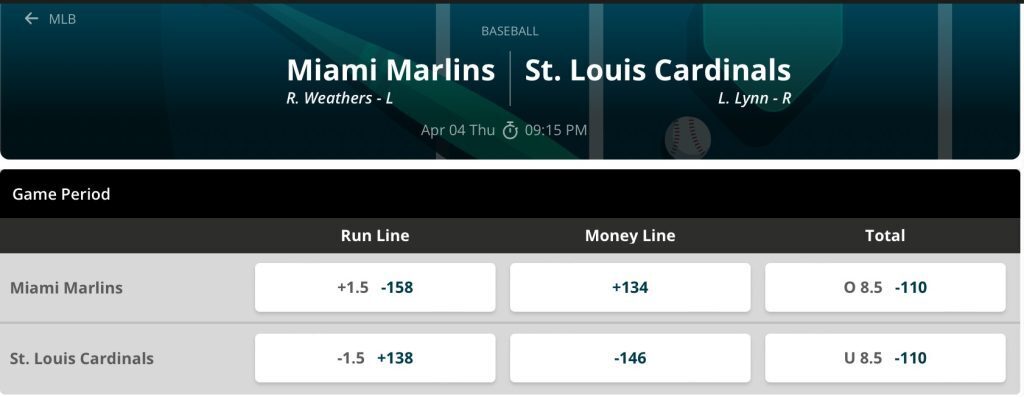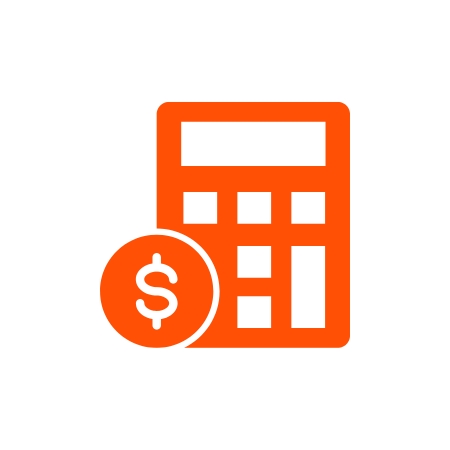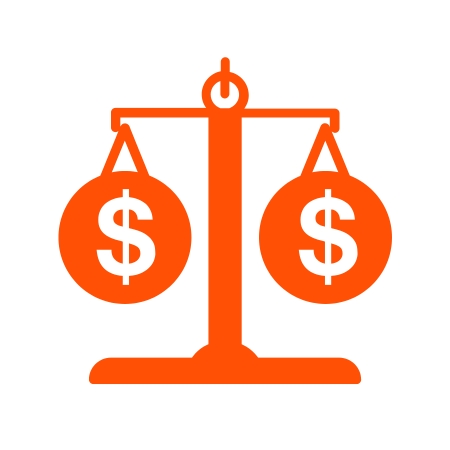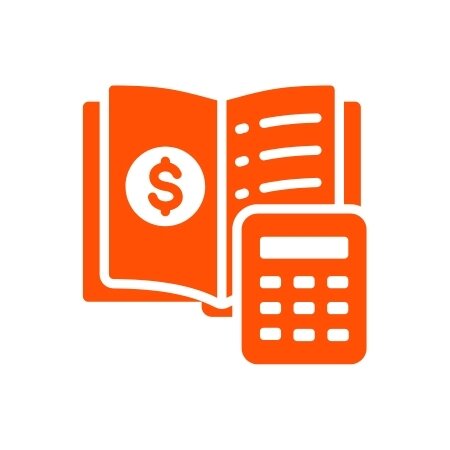Sports Betting Math How To Make Money Sports Betting
Basics of Sports Betting Math
Understanding the math behind sports betting is the first step to placing effective bets. Here’s an example of a common moneyline bet that you’ll encounter in any sportsbook.

The Marlins are due to play the Cardinals in a regular season MLB game. BetOnline offers this moneyline:
- Marlins: +134
- Cardinals: -146
The odds show that you will win $134 profit for every $100 wagered on the Marlins, assuming they win. Meanwhile, you will need to stake $146 on the Cardinals to win $100 profit (again, assuming they win).
This means that the Cardinals are favorites to win per the bookie’s analysis, because you will earn less profit for every $100 wagered, compared to the Marlins.
The easiest way to think about sports betting math is to look at the number. The lower the number (expressing the payout odds), the more likely you are to win in the bookie’s vision, but your potential profit is also lower. Higher numbers carry greater profit potential, but are riskier bets.
How To Make Money Sports Betting
You can earn a lot of money sports betting, but it requires attention to detail and some work. There is a myth that luck dictates whether you win or lose sports bets. Making smarter decisions and understanding sports betting math will help you reduce your reliance on luck.
In order to earn a profit in sports betting you need to win more times than you lose overall. However, it’s not a 50/50 split. Bookies make money by taking a small percentage of all bets placed, called vigorish or juice. This means that successful bettors need to win roughly 53% of the time to break even.
How To Use Sports Betting Math
All successful sports betting strategies begin with establishing a knowledge base so you can deploy your strategy. By understanding the math behind sports betting, you can automate smart decisions.
Here are the foundation blocks we recommend you establish before you start betting:
1. Understand Betting Odds and Lines
It’s important to understand how betting odds work and visualize the likelihood of winning with these numbers. In sports betting, higher odds can be interpreted as a reduced likelihood of winning and, therefore, a riskier bet. The upshot is that your potential profit is higher.
What is implied probability?
Implied probability is not mathematical probability (or true odds), but just another way to express the payout odds. In fact, this is the main principle of strategic sports betting – finding bets where you estimate their true odds as different from the bookie’s odds.
Calculating true odds vs. implied odds can be tricky. Click here to read more about betting odds.
Example: Any odds above +100 carry a <50% implied probability, but are more profitable. Any odds below -100 have a >50% implied probability, but are less profitable.
The problem is, betting sites also take a slice of each stake before a bet is even settled. This makes it common to see lines such as:
- Golden State @ -110
- Bulls +8.5 points @ -110
In this example, both teams are -110 to win, although the Bulls also have a +8.5 point advantage to level out the odds. Even though both outcomes may have a 50% chance of winning as true odds, your profit will be $91 for every $100 wagered, not $100, because of the vigorish. The implied probability for either of these lines is 110/210 = 52.38%, totaling 104.76%. Numbers above 100% reflect the bookie’s vigorish.
2. Outline a Profit Margin and Factor In Vigorish
It’s important to factor in the ‘house take’ when creating your profit margin and working out your betting strategy.
Your profit margin is what you expect to walk away with after the sportsbook has taken its share. If you win even money exactly 50% of the time, then you will lose overall because of vigorish.
This means that bettors are required to wager at higher odds to cover the house take. This might only be a few percentage points, but that is why most bettors target a minimum 5% profit margin. To do this, you need to win an average 55% of the time.
3. Calculate Expected Value
You can use your projected profit margin when calculating expected value in your bets. This is your average profit over the long run.
Example: If you want to win 55% of the time, in order to generate a small profit and cover the vigorish paid to your sportsbook, then you need to focus on negative odds:
- Odds of -122 carry an implied probability of just under 55% and pay out $82 as profit for every $100 staked.
- If you place 10 bets worth $100 each and you win all 10 bets, then you’ll earn $820. However, that probably won’t happen, and your realistic target will be to win at least 55% of the time.
- Winning 55% of the time means that you’ll earn a $451 profit from the won bets – $450 (from the lost bets) = $1 overall profit. Any additional bet won will increase your overall profit by $82.
Or you can wager on positive odds and get a better outcome, but with higher risk:
Odds of +122 carry an implied probability of 45% and pay out $122 as profit for every $100 staked.
If you place 10 bets worth $100 each and you win all 10 bets, then you’ll earn $1,220. Again, that probably won’t happen, but your target is to win at least 45% of the time to have profit.
Winning 45% of the time means that you’ll earn a $549 profit from the won bets – $550 = – $1 up overall (one additional bet won increases your profit to $121).
4. Understanding Basic Statistical Data
The final part of your sports betting foundation should focus on smart decisions based on historical data. The best online sportsbooks provide data banks for bettors that include:
- Team Records & Form Guides
- Head-To-Head Records
- Player Stats
- League Stats
- Interesting Facts
The key is to spot historical trends and match them with the betting odds.
Example: If you bet on New York Giants @ Washington. The Commanders are -150 to win. However, you spot that the Giants hold the record for the most wins of any team against any other team (107). Historic data hints at another Giants win and their odds of +230 suddenly look worthwhile.
Putting Betting Math Into Action: Betting Strategies
Now that you have a strong foundation for placing bets and the basic math behind them, it’s time to apply betting mathematics to your choices. The basic principle is to convert odds into implied probability and then figure out:
A. Whether the odds meet your desired profit margin
B. Whether there is underlying value in the bet
Here are some key sports betting strategies that use math to help you spot valuable wagers that align with your foundation:

Value Betting:
Sportsbooks strive to give accurate odds, but don’t always get it right. If you spot odds at greater value than normal, then they might be worth backing, even if your win probability is still low.
Example: The USMNT are +900 to beat Wales at the World Cup. Those odds read as a 10% implied probability, which seems crazy because the US team is undefeated this year. It is fair to assume that the team has a greater chance of winning than the odds suggest, so you back them.

Sharpening Your Handicapping:
You can use math to adjust for a team’s strengths and weaknesses.
Example: If the Padres are -310 to beat the Marlins with a -1.5 handicap. That reads as a 75.6% implied probability, but you know the Padres are in form and have already won the series. If you nudge the line to -3.5, then the odds rise to -110.

Effective Money Management:
It’s important to keep an eye on your bankroll when betting on sports. A smart strategy is to:
- Make an affordable deposit
- Equally split the amount into the number of bets you plan to make (for example, by using betting units)
Doing this will save you from blowing your budget on a single bet and save you from spending your profit if you land a big payout.

Arbitrage Betting:
Sportsbooks try to offer the same odds as their rivals, but smart bettors can take advantage of price discrepancies. Arbitrage betting requires you to join more than one sportsbook and bet on opposite outcomes.
Example: You could bet on the 49ers to beat the Rams at +200 on one site, and the Rams to win at +220 on another. No matter who wins, you’ll make a profit if you choose your stakes wisely.
Tip: Read our arbitrage betting guide to master this betting strategy.

Live Betting Math:
Reacting to events in-play and timing smart bets is no easy task. It can take pro bettors years to master live betting. Using math certainly helps. By making quick value calculations, you can determine whether a bet is worth placing as the play unfolds.
Example: You’re tracking the moneyline odds in a boxing match. The favorite has won the first four rounds and his moneyline odds have sunk. However, he looks tired and the underdog delivers a few big blows in the fifth round.
The underdog has odds of +400 (20% implied probability) but they’re starting to come in. You figure the underdog has a 45% chance of winning this fight now, so they’re worth backing at +400.
Advanced Strategies for Making Money Betting On Sports
Spotting value, managing your money, and using arbitrage tactics are good starting points for new bettors. Advanced gamblers can use math to tap into more advanced betting strategies. Here are three advanced betting strategies to consider:
Hedging:
Hedging is all about minimizing your losses and securing profits no matter how small. Hedge betting requires you to effectively wager against your initial bet until you win, no matter the result.
Example: You bet on the Lions to beat the Steelers at odds of +300. The Lions take a 21-7 half-time lead and their live odds fall to -400, while the Steelers’ odds rise to +500. So, you wager on the Steelers and lock in profit, no matter the final result.
Kelly Criterion:
The Kelly Criterion betting system is a formula that pro handicappers use to find the optimal size of a certain bet, relative to their bankroll, for maximizing their bankroll’s growth rate over time.
Here’s the formula:
f* = (bp – q) / b
- f* is the fraction of your overall bankroll that you should bet
- b is the net payout rate of the bet
- p is the estimated probability of winning
- q is the estimated probability of losing
Example: You have a $100 bankroll and find a bet at odds of +200. Assume you estimated a probability of winning the bet of 40%. A $100 bet pays out $200 as profit, so b = 2. Probability q is 1 – 40% = 60%
Here’s the calculation:
- f* = (2 x 40% – 60%) / 2 = 0.10
Therefore, the maximum you should place on this wager is 10% of your overall budget, which is $10.
In this example, implied odds are 33.33%, which are lower than the estimated probability of winning of 40%. This means that the bet has a positive expected value.
This is the required condition for the Kelly criterion to be applicable: the implied probability of the bet needs to be lower than the estimated probability of winning.
The Kelly criterion only works for bets with positive expectation. It is a strategy applicable to “profitable” bets, for making them more profitable with respect to your bankroll.
Statistical Modeling:
Statistical modeling can give you an edge over a sportsbook, if you follow the stats and stay committed. Pro bettors will focus on a reliable stat they can track over weeks and months.
Example: You focus on Buffalo’s total rushing yards per quarter in the regular season. You notice Buffalo averages 134 rushing yards per game. That splits to 33.5 yards per quarter.
Using this information, you can build a statistical model where you bet above or below the 33.5 yard mark in each quarter of a Buffalo game. Find a site that offers good odds of +29.5 yards, and you should win more times than you lose.
Tips for Maintaining Your Betting Math Strategy
Betting strategies only work if you use them correctly. If you get spooked by a series of losses and stray away from the strategy, then you risk losing a lot more money.
No strategy is foolproof, but relying on math is the best way to organize your betting for delivering profits.
To do this, you need to stay on track. We recommend keeping a ledger of your wins and losses, so you can track the trend and ensure you’re on the right trajectory. If you suffer a blip, then so be it.
Here are three foolproof ways to help you stay true to your strategy:

Discipline and Patience:
Any betting strategy requires patience. It can take a long time to earn small, regular wins and reach your targeted profit total. You can also blow your entire bankroll in an instant if you don’t stay patient and chase a windfall.
Being disciplined and sticking to your strategy isn’t easy. One big mistake bettors make is to wager on their favorite team. It can be difficult not to back your team when you want them to win, but this can lead to bad decisions.
TIP: Bet on a sport you know well, but stay away from betting on teams you love or hate. This will take the emotion out of your betting strategy.

Record Keeping:
Keep a ledger of your wins and losses, so you can spot trends and make adjustments to your betting strategy. Using betting math will help, because you can quickly spot what makes a promising bet, and where you’re on the verge of wasting your money.
Some bettors like to keep handwritten ledgers of all their wagers, but a smarter option is to use something like Google Sheets or Microsoft Excel and create a spreadsheet to pull trends from.

Knowing When To Fold:
Everyone loses bets now and again. Sometimes knowing when to fold and accept defeat is the best option, instead of doubling down and making things worse. If you’ve bet $100 on the Bruins to beat the Oilers and they’re 8-0 down with 10 minutes remaining, then it’s time to say goodbye to that $100.
Remember, a 55% betting strategy means you will lose 45% of the time. So long as you stay on top of the math and remain disciplined, then you stand the best chance possible of winning profit by the end.
Responsible Gambling
We encourage all players to gamble responsibly. Online betting should be viewed as a form of entertainment, not a source of income. Set loss and time limits, and budget your bankroll to avoid overspending. Responsible gambling isn’t about dampening the fun — it’s about ensuring the fun continues. Following these tips will help you enjoy betting while staying in control.
If you find yourself preoccupied with gambling or regularly exceeding your budget, consider the resources below for help:
- National Council on Problem Gambling: (202) 547-9204 or NCPGambling.org
- AGA Responsible Gambling Code of Conduct (as supported by the NBA)
- Gambler’s Anonymous: gamblersanonymous.org/ga/
- Responsible Gambling Council: https://responsiblegambling.org/
Key Takeaways: How To Win Using Sports Betting Math
If you want to make money on sports betting, then understanding the math behind the odds is the first step to making a profit. By using math-based techniques, from calculating profit margins to hedging to arbitrage, you can maximize your chances of beating a sportsbook and winning more than you lose.
From basic money management to complex formulas, this guide has provided you with a useful reference when planning your betting strategy. Now you can make smarter bets at the top sportsbooks and try to beat the bookies. Good luck! We’re rooting for you!
Other Sports Betting Strategy Resources and Guides
Expert sports bettors use the full range of tools and resources available to them when placing bets. This covers everything from using betting math to make picks, to knowing how bookies make money.
We recommend reading our handy guides to get up to speed and place smarter bets:
Sports Betting Calculator Let our calculator do the math for you and work out your potential profit before you bet.
Winning Betting Strategy Can you make money sports betting? Of course! Learn how in our strategy guide.
Point Spreads Understand what point spreads are and how to create a strategy around them.
Totals Learn about totals in sports betting and get tips on how to bet on totals effectively.
Teaser Betting Teaser bets let you adjust the spread and totals on your parlay and improve your chances of winning. Read our teaser strategy guide before diving in.
Sweetheart Teasers Combine larger number of teasers into a single "Sweetheart", or "Monster", teaser bet.
Understanding Value Finding value in a sportsbook can make a huge difference in your profit potential and we have some quick tips to get you started.
Parlay Betting Develop a parlay bet strategy that works with our guide.
Prop Betting Utilize prop bets as an alternative to betting on straight game outcomes.
Future Betting Find favorable odds by betting early on the final outcome of future competitions and events.
Yahoo! Sports Stats Use Yahoo’s extensive stats network to find the trends you’re looking for.
Introduction to Sports Betting CNN shows you how sports betting works if you’re new to the game.



